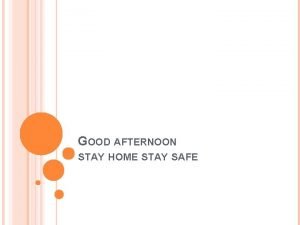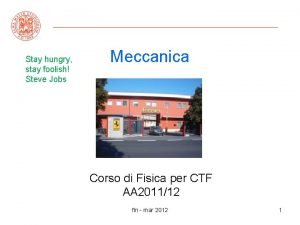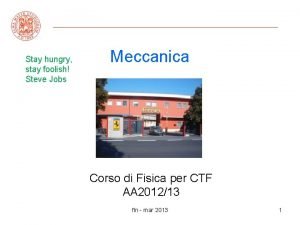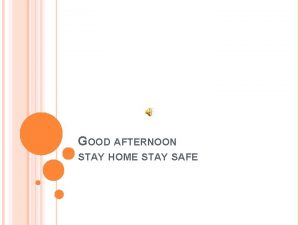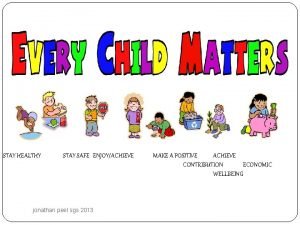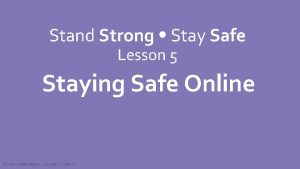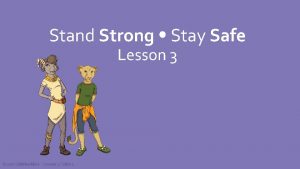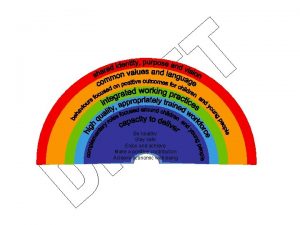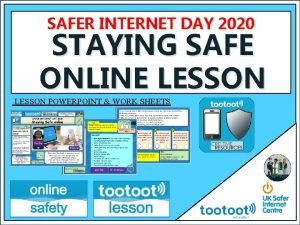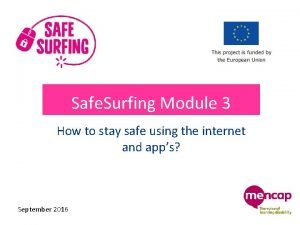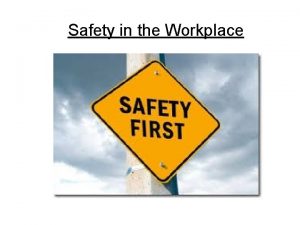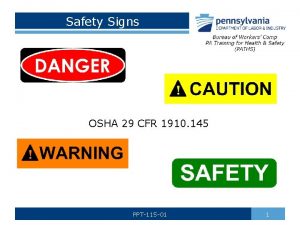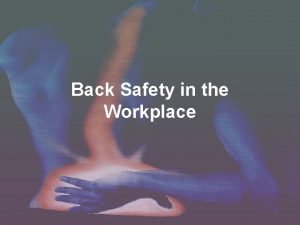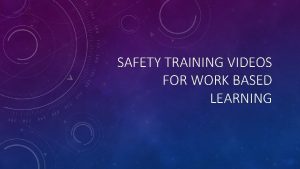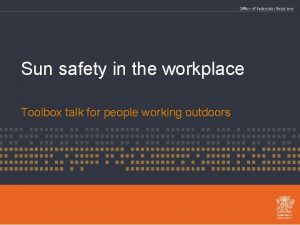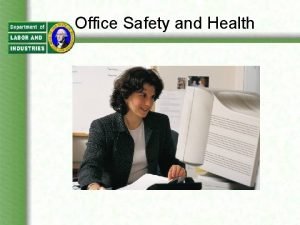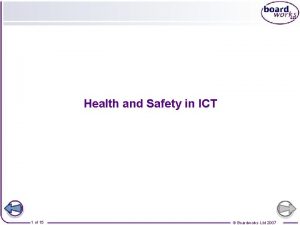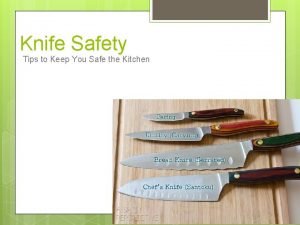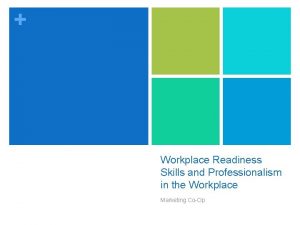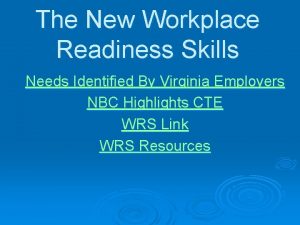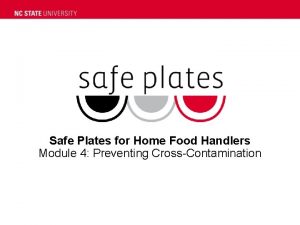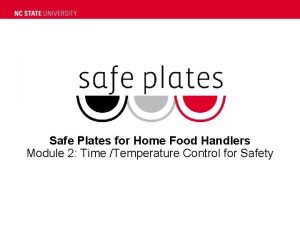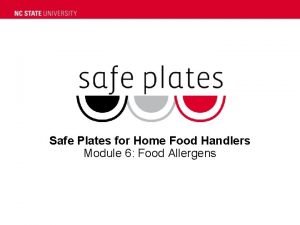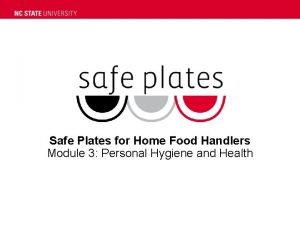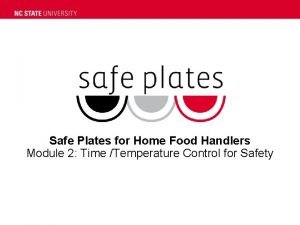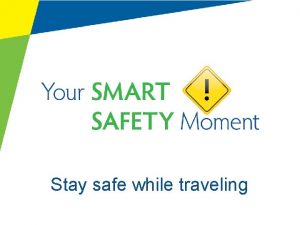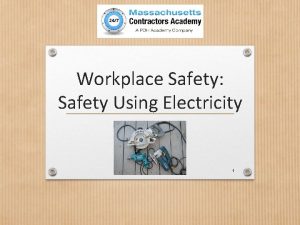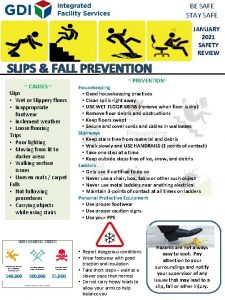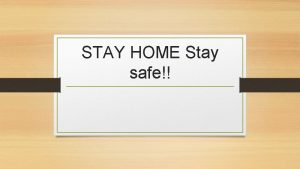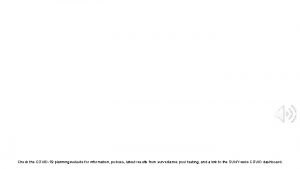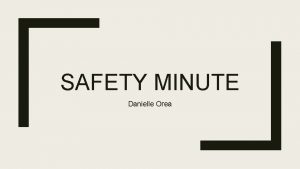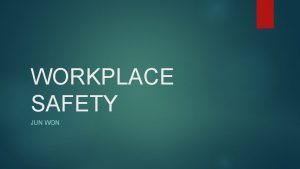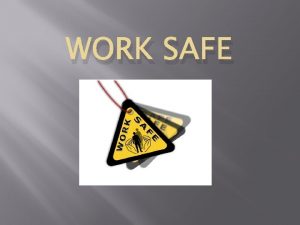Work Safe Stay Safe Module 1 Workplace Safety


































- Slides: 34

Work Safe Stay Safe Module 1 Workplace Safety Program

What You Should Know • You have the right and responsibility to be safe at work. • Your employer has the responsibility to provide a workplace free from safety hazards. • OSHA is the US Government agency that protects your safety rights. • Know how to protect yourself and others from accidents. Workplace Safety Program

The Right to Be Safe at Work Question: In the United States 12 workers are killed on the job-q each year? q each month? q each week? q each day? Workplace Safety Program

The Right to Be Safe at Work 12 workers are killed on the job-q each year? q each month? q each week? ü each day Too many of these accidents happen to temporary workers. Temporary workers have the right to safety training and health protections like any worker. Workplace Safety Program

Making a Living Shouldn’t Cost Lives 2014, Rantoul: Temporary worker killed in fall from third floor loading platform. 2013, Schaumburg: Temporary worker died after forklift he was operating fell between truck and dock. 2013, Aurora: Temporary worker was fatally crushed by a mechanical gate. Workplace Safety Program

What is a Safety Hazard? A safety hazard, if left uncontrolled, can result in an injury or illness. Workplace Safety Program

Common Safety Hazards Chemical Explosion Electrical Ergonomics Excavation (Collapse) Fall Fire/Heat Mechanical Noise Radiation Struck By/Struck Against Temperature (Heat/Cold) Visibility Weather Workplace Safety Program

Recognize Any Hazard(s)? Workplace Safety Program

Yes Spliced electrical extension cords. Extension cords should be marked DO NOT USE. Also, bad housekeeping, trip hazard and unprotected hole in photograph. Workplace Safety Program

Recognize Any Hazard(s)? Workplace Safety Program

YES Employer was operating a standing fan without grounding protection Workplace Safety Program

Recognize Any Hazard(s)? Workplace Safety Program

Yes Ladder to work platform is not of sufficient length. It must extend 3 feet above the working surface. Workplace Safety Program

Recognize Any Hazard(s)? Workplace Safety Program

Yes Grinding or striking materials can create flying object hazards. This worker is protected by equipment guarding and faceshield, but should have safety glasses/goggles Workplace Safety Program

Recognize Any Hazard(s)? Workplace Safety Program

Yes Caught-in hazards occur when a worker could be caught inside of or in between different objects Workplace Safety Program

Recognize Any Hazard(s)? Workplace Safety Program

Yes Gloves, long sleeve shirts, jewelry, or loose fitting clothing can be hazardous if caught in moving parts. Workplace Safety Program

Recognize Any Hazard(s)? Workplace Safety Program

Yes Employee could be caught between track of dozer and wall Workplace Safety Program

What Should You Do if You Find a Safety Hazard? Keep working and don’t tell anyone? Tell your co-workers? Tell your supervisor? Tell your staffing agency? Workplace Safety Program

What Should You Do if You Find a Safety Hazard? Keep working and don’t tell anyone? Tell your co-workers Tell your supervisor Tell your staffing agency Both your employer and your staffing agency are responsible to provide a safe work area. But it is your responsibility, too. Workplace Safety Program

What Your Employer Should Do Protect workers by preventing anyone from using or being near hazards. Remove the hazard. Report any serious accident to OSHA within one day. Keep a record of all accidents and illnesses using OSHA’s Form 300 Log. Workplace Safety Program

Your Safety Rights are Protected by OSHA You have the right to: • tell your employer or OSHA about safety hazards • request an inspection from OSHA • see OSHA citations issued to your employer • request a copy of your workplace medical records or exposures to chemical, biological, or environmental hazards Workplace Safety Program

Filing a Complaint with OSHA You can file a complaint online at the OSHA website, by mailing or faxing in a complaint form, or by calling the OSHA office to discuss your concern (1 -800 -321 -OSHA). Include enough information for OSHA to determine that a safety hazard probably exists, such as: • How many people are exposed to the hazard? How? When? • Have there been any attempts to correct the problem? • Has anyone been injured or made ill as a result of the problem? Workplace Safety Program

How OSHA Responds to Complaints OSHA will evaluate each complaint to determine how it can be handled best--an off-site investigation or an onsite inspection. OSHA staff must be able to determine from the complaint that there are reasonable grounds to believe that a violation or a safety or health hazard exists. Complaints are not necessarily inspected in "first come, first served" order. OSHA ranks complaints based on the severity of the alleged hazard and the number of employees exposed. Workplace Safety Program

Your Employer Cannot Retaliate Protection means that an employer cannot retaliate, or take any action against you for exercising your safety rights, such as: • intimidate you, make threats • reduce your pay or hours • fire or lay you off, fail to hire or rehire you • demote you, deny you overtime or a promotion • discipline you • deny you of benefits f f O d i a L Call OSHA within 30 days Workplace Safety Program

What do you think? Workplace Safety Program

Look for This Poster at Your Workplace Safety Program

Your Responsibilities To learn how to: • operate machines safely • work with chemicals safely • work around forklifts safely • wear personal protective equipment To think and act safely To tell the truth about safety hazards and accidents Workplace Safety Program

Remember You have the right and responsibility to be safe at work. Your employer has the responsibility to provide a workplace free from safety hazards. OSHA is the US Government agency that protects your safety rights. Know how to contact OSHA to protect yourself and others from accidents. Workplace Safety Program

What do you think? 1. What is the name of the federal agency that protects the health and safety of workers? 2. Who is responsible for your safety at work? a)your employer b)your staffing agency c)you d)all of the above 3. Your employer can fire you if you say anything about your safety. True or False? Workplace Safety Program

Susan Harwood Training Program The focus of the program is to provide training and education for workers and employers on the recognition, avoidance, and prevention of safety and health hazards in their workplaces, and to inform workers of their rights and employers of their responsibilities under the OSH Act. Target audiences include underserved, lowliteracy, and workers in high-hazard industries. Since 1978, over 1. 8 million workers have been trained through this program. Disclaimer: This material was produced under grant number SH-27685 -SH 5 from OSHA. It does not necessarily reflect the views or policies of the U. S. Department of Labor, nor does mention of trade names, commercial products, or organizations imply endorsement by the U. S. Government. 02/2016 Workplace Safety Program
 Stay home stay safe good afternoon
Stay home stay safe good afternoon Good morning and stay safe
Good morning and stay safe Where you go i'll go where you stay ill stay
Where you go i'll go where you stay ill stay What does stay hungry stay foolish mean
What does stay hungry stay foolish mean My wish for you is that life becomes
My wish for you is that life becomes So stay so stay 再知己
So stay so stay 再知己 Summary of to daffodils
Summary of to daffodils Stay tuned stay foolish
Stay tuned stay foolish Stay hungry stay foolish significato
Stay hungry stay foolish significato Good afternoon stay healthy
Good afternoon stay healthy Describe kat's tribute costume
Describe kat's tribute costume Be healthy stay safe enjoy and achieve
Be healthy stay safe enjoy and achieve Stand strong stay safe
Stand strong stay safe Stand strong stay safe
Stand strong stay safe Be healthy stay safe enjoy and achieve
Be healthy stay safe enjoy and achieve Stay safe protect each other
Stay safe protect each other We're always being urged to stay safe online
We're always being urged to stay safe online Stay safe
Stay safe Workplace safety vocabulary
Workplace safety vocabulary Chapter 10 workplace safety procedures
Chapter 10 workplace safety procedures 29cfr1910 120
29cfr1910 120 Back safety in the workplace
Back safety in the workplace Free osha training videos
Free osha training videos Sun safety toolbox talk
Sun safety toolbox talk Office hazards
Office hazards Health and safety
Health and safety Knife safety tips
Knife safety tips Workplace readiness skills-positive work ethics
Workplace readiness skills-positive work ethics Workplace readiness skills positive work ethics answer
Workplace readiness skills positive work ethics answer C device module module 1
C device module module 1 Servsafe module 4
Servsafe module 4 Safe plates
Safe plates Safe plates module 6
Safe plates module 6 Safe plates module 3
Safe plates module 3 Tcs food examples
Tcs food examples
